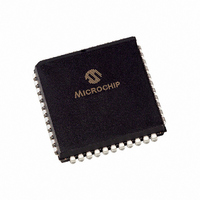PIC18C452-E/L Microchip Technology, PIC18C452-E/L Datasheet - Page 4

PIC18C452-E/L
Manufacturer Part Number
PIC18C452-E/L
Description
IC MCU OTP 16KX16 A/D 44PLCC
Manufacturer
Microchip Technology
Series
PIC® 18Cr
Datasheets
1.PIC16F616T-ISL.pdf
(8 pages)
2.PIC16C770-ISO.pdf
(8 pages)
3.PIC18C242-ISO.pdf
(305 pages)
4.PIC18C242-ISO.pdf
(12 pages)
Specifications of PIC18C452-E/L
Core Processor
PIC
Core Size
8-Bit
Speed
40MHz
Connectivity
I²C, SPI, UART/USART
Peripherals
Brown-out Detect/Reset, LVD, POR, PWM, WDT
Number Of I /o
33
Program Memory Size
32KB (16K x 16)
Program Memory Type
OTP
Ram Size
1.5K x 8
Voltage - Supply (vcc/vdd)
4.2 V ~ 5.5 V
Data Converters
A/D 8x10b
Oscillator Type
External
Operating Temperature
-40°C ~ 125°C
Package / Case
44-PLCC
Processor Series
PIC18C
Core
PIC
Data Bus Width
8 bit
Data Ram Size
1.5 KB
Interface Type
MSSP, SPI, I2C, PSP, USART
Maximum Clock Frequency
40 MHz
Number Of Programmable I/os
34
Number Of Timers
1 x 16 bit
Operating Supply Voltage
2.5 V to 5.5 V
Maximum Operating Temperature
+ 125 C
Mounting Style
SMD/SMT
3rd Party Development Tools
52715-96, 52716-328, 52717-734, 52712-325, EWPIC18
Development Tools By Supplier
ICE2000, DM163022, DV164136
Minimum Operating Temperature
- 40 C
On-chip Adc
8
For Use With
I3DB18C452 - BOARD DAUGHTER ICEPIC3DVA16XL441 - ADAPTER DEVICE ICE 44PLCC
Lead Free Status / RoHS Status
Lead free / RoHS Compliant
Eeprom Size
-
Lead Free Status / Rohs Status
Details
Other names
PIC18C452E/L
Available stocks
Company
Part Number
Manufacturer
Quantity
Price
Company:
Part Number:
PIC18C452-E/L
Manufacturer:
Microchip Technology
Quantity:
10 000
PIC18CXX2
11. Module: I/O (PORTB
DS80058H-page 4
The RB Port Change Flag bit of the INTCON reg-
ister (RBIF, INTCON<0>) may be inadvertently
cleared, even when the PORTB<7:4> pins have
not been read. This will occur only when the follow-
ing two conditions occur simultaneously:
•
•
Work around
All work arounds will involve setting the contents of
BSR<3:0> to some value other than 0Fh. In addition
to those proposed below, other solutions may exist.
1. When developing or modifying code, keep
2. If accessing a part of Bank 15 is required and
3. If pointing the BSR to Bank 15 is unavoidable,
The four Least Significant bits of the
BSR register are equal to 0Fh
(BSR<3:0> = ‘1111’), and
Any instruction that contains 81h in its
8 Least Significant bits (i.e., register file
addresses, literal data, address offsets,
etc.) is executed.
these guidelines in mind:
•
•
•
the use of Access Banking is not possible,
consider using indirect addressing.
review the absolute file listing. Verify that no
instructions contain 81h in the 8 Least Signifi-
cant bits, while the BSR points to Bank 15
(BSR = 0Fh).
Assign 12-bit addresses to all variables.
This allows the assembler to know when
Access Banking can be used.
Do not set the BSR to point to Bank 15
(BSR = 0Fh).
Allow the assembler to manipulate the
Access bit present in most instructions.
Accessing the SFRs in Bank 15 will be
done through the Access Bank. Con-
tinue to use the BSR to select Banks 1
through 5, and the upper half of Bank 0.
Interrupt-on-Change)
12. Module: Interrupts
When an interrupt occurs simultaneously with the
clearing of one or more interrupt enable flags in the
INTCON, PIE1 or PIE2 registers, the instruction
immediately following the interrupted instruction
may be executed before vectoring to the Interrupt
Service Routine (ISR). If that instruction is a con-
trol operation, the ISR may not execute as
intended.
In the case of conditional branch instructions, the
first instruction of the ISR may be skipped if the
tested condition would have resulted in a branch.
In the case of GOTO, CALL, or BRA instructions,
program execution may vector to the address
encoded in the instruction; the ISR will not be exe-
cuted at all. The GIE bit will still be cleared, dis-
abling all interrupts.
Additionally, on return from the interrupt (by exe-
cuting RETFIE), the instruction following the inter-
rupted instruction may be executed again.
There may be other interrupt related symptoms.
Work around
Three possible solutions are presented here.
Other solutions may exist. None of these require
special attention when setting interrupt enable bits.
1. All instructions that clear interrupt enable bits
2. Prior to disabling any interrupt source, disable
3. If interrupt priority is being used:
should be followed by a NOP instruction.
all
(INTCON<7>). After disabling the desired inter-
rupts, re-enable all interrupts by setting GIE.
a) clear both GIEL and GIEH (in order) bits
b) clear the desired interrupt enable bits
c) set both GIEH and GIEL, in order to re-enable
(INTCON<7:6>) to disable all peripheral
interrupts
peripheral interrupts
interrupts
by
2002 Microchip Technology Inc.
clearing
the
GIE
bit
















